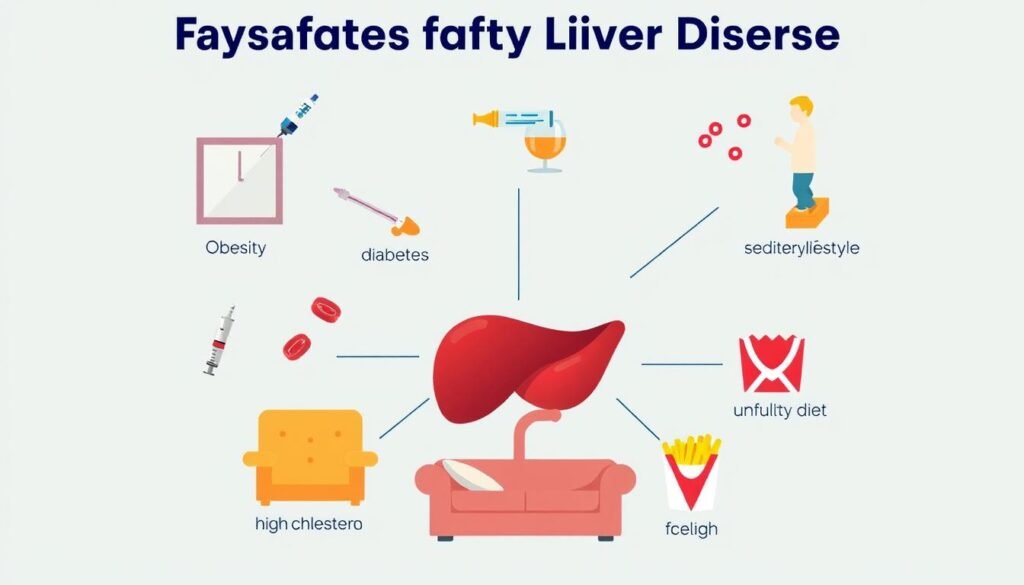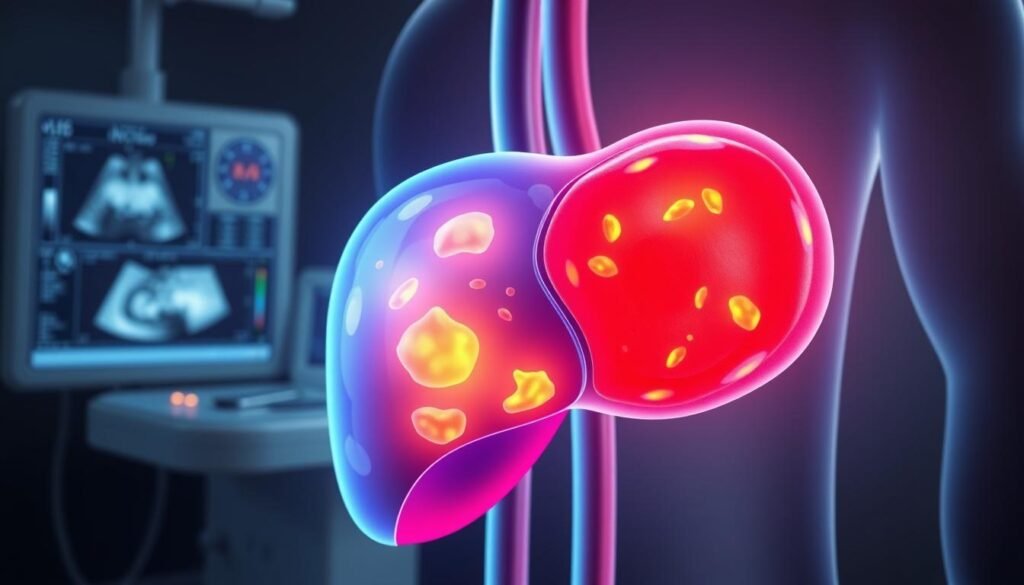Ever wondered about a silent condition like fatty liver disease that could cause big health issues without noticeable symptoms? This raises the need to know about Non-Alcoholic Fatty Liver Disease (NAFLD). It’s a major issue for liver health.
NAFLD happens when too much fat builds up in the liver but without the usual signs of worse damage. Around 24% of U.S. adults have NAFLD, showing how widespread yet ignored this condition is. As obesity rates climb, especially in Middle Eastern and Western countries, so does NAFLD’s spread.
This piece sheds light on what causes fatty liver, its symptoms, and how lifestyle changes can help manage it. For deeper understanding, do check this thorough article.
Key Takeaways
- Understanding fatty liver disease is essential for overall health awareness.
- NAFLD is the most common form of liver disease worldwide.
- Routine monitoring can aid in early detection and intervention.
- Weight management and lifestyle changes significantly improve liver health.
- Awareness of risk factors can help mitigate the condition’s progression.
- NASH, a more advanced stage of liver disease, requires proactive management.
Understanding Non-Alcoholic Fatty Liver Disease (NAFLD)
Non-Alcoholic Fatty Liver Disease, or NAFLD, is a major health issue. It happens when fat builds up in the liver without much alcohol use. About 25 percent of people worldwide have it, especially those who are overweight or obese.
NAFLD can be minor, without symptoms, or more severe, causing inflammation and liver damage. If not managed well, it can lead to serious liver problems.
The main causes of NAFLD relate to being overweight, resistant to insulin, and having type 2 diabetes. These issues greatly increase the risk of liver disease. Doctors say living a healthy life, like losing weight and eating better, is key to managing NAFLD.
Right now, there are no special medicines for NAFLD. But changing your lifestyle can really help reduce liver fat and swelling.
Finding out if you have NAFLD involves looking at your medical history, physical checks, blood tests, and imaging tests. Learning about how doctors diagnose it is vital. Spotting it early can stop it from getting worse.
To wrap up, NAFLD is a big public health issue. It shows why knowing about it, preventing it, and managing it are so important to fight this common liver disease.
What is Hepatic Steatosis?
Hepatic steatosis, or fatty liver, happens when liver cells store too much fat. This condition is a part of non-alcoholic fatty liver disease (NAFLD) and often comes without inflammation. It shows the liver is dealing with too much stress. Experts think that by 2030, around 100 million people in the U.S. could get NAFLD. This issue might cost about $103 billion every year in medical expenses.
Being overweight or having issues like insulin resistance can lead to fatty liver. Up to 30% of adults in wealthy countries might have it. Also, about a third of those with NAFLD could develop more serious liver problems, such as cirrhosis.
Doctors look at things like body mass index (BMI), blood pressure, and sugar levels to check liver health. Around 75% of overweight individuals and over 90% of those who are very obese may develop fatty liver. Additionally, up to two-thirds of people with type 2 diabetes might have it too, showing how these health issues are linked.
It’s important to know about fatty liver because making changes to your lifestyle can help. Staying healthy and checking on your liver can prevent the disease from getting worse.
| Risk Factors | Associated Conditions | Prevalence |
|---|---|---|
| Obesity | NAFLD | 75% in overweight individuals |
| Type 2 Diabetes | NASH | 33% to 66% with NAFLD |
| Insulin Resistance | Advanced Fibrosis | Varied rates based on population |
| Genetic Variants (e.g., PNPLA3) | Various metabolic syndromes | Emerging evidence |
Causes of Fatty Liver Without Inflammation
It’s important to know why fatty liver without inflammation happens. Experts point to several key reasons. These include obesity, insulin resistance, type 2 diabetes, and metabolic syndrome. All of these can cause too much fat to build up in the liver.
People with type 2 diabetes often have non-alcoholic fatty liver disease (NAFLD), up to two-thirds of them. Being overweight is a big risk. Around 75% of overweight people have NAFLD. For those with severe obesity, the number jumps above 90%. Even kids are affected. Almost 10% of kids in the U.S., from ages 2 to 19, have signs of NAFLD.
About 24% of adults in the U.S. have NAFLD, and some may develop non-alcoholic steatohepatitis (NASH). The risk factors for NAFLD often match those for metabolic syndrome. This includes being overweight, having high blood pressure, low HDL cholesterol, and high triglycerides.
These issues lead to too much fat in the liver, making it hard for the liver to work right. High blood sugar and cholesterol levels can also make hepatice steatosis worse. This makes finding the right treatment crucial.
| Contributing Factors | Description | Impacts on Liver Health |
|---|---|---|
| Obesity | Excess body fat increases liver fat storage. | Higher risk of NAFLD and NASH development. |
| Insulin Resistance | Impaired ability to regulate blood glucose levels. | Directly links to increased liver fat accumulation. |
| Type 2 Diabetes | Chronic condition affecting metabolism. | Significant overlap with NAFLD cases. |
| Metabolic Syndrome | Combination of conditions such as obesity and high triglycerides. | Elevates overall risk for liver diseases. |
| High Blood Sugar | Excess glucose can lead to fat storage in the liver. | Compounds risk factors for liver conditions. |
Key Risk Factors for Fatty Liver Disease
It is vital to know the risk factors for fatty liver to identify who might be most at risk. Obesity, especially central obesity, greatly increases the chances of developing fatty liver disease. Those with obesity face many health issues, like metabolic syndrome. This syndrome includes problems like hypertension, high blood sugar, and high cholesterol.
Metabolic syndrome is a big risk factor that can cause severe health issues, including fatty liver. It often comes with insulin resistance, making liver health worse. Also, those with Type 2 diabetes are at a higher risk for fatty liver. Remarkably, 80-90% of obese adults may have primary NAFLD. This shows how critical it is for people with obesity to change their lifestyle.
Certain biological factors also make people more prone to fatty liver disease. Things like high cholesterol, high triglycerides, and a family history of liver disease need attention. We must not ignore diet’s role; eating lots of saturated fats can lead to obesity and, in turn, increase fatty liver risk.
Many adults have several risk factors at the same time, which is common in middle-aged adults. This highlights how widespread fatty liver disease is. Thus, regular check-ups and early action are crucial to lower these risks. Below is a table showing the main risk factors for fatty liver disease:
| Risk Factor | Description | Prevalence |
|---|---|---|
| Obesity | Central obesity significantly increases the likelihood of fatty liver. | 80-90% in obese adults |
| Metabolic Syndrome | A cluster of conditions that increase heart disease and diabetes risk. | Linked to up to 1 in 3 adults |
| High Blood Cholesterol | Elevated cholesterol levels contribute to liver fat accumulation. | Common in 20-80% of NAFLD cases |
| Family History | Genetic predisposition to liver diseases can raise susceptibility. | Considered a significant risk factor |

Symptoms of Fatty Liver Without Inflammation
Fatty liver without inflammation is often hard to catch early. Many people don’t know they have it since symptoms are rare. Some may feel fatigue, unwell, or discomfort in the upper belly. These mild signs are key for catching the disease early.
When the disease gets worse, symptoms like discomfort can increase. In severe cases, signs like jaundice and swelling show up. It’s critical to pay attention to these early symptoms.
To find this disease early, doctors use imaging or blood tests. This is because most folks don’t show symptoms until the liver is badly damaged. Those who are overweight, have diabetes, or high blood pressure should watch out. These factors raise the risk of fatty liver disease.
| Symptom | Description |
|---|---|
| Fatigue | A persistent feeling of tiredness that does not improve with rest. |
| Discomfort | General discomfort, especially in the upper abdomen where the liver is located. |
| Malaise | A feeling of unease or discomfort, often accompanying other symptoms. |
| Jaundice | A yellowing of the skin and eyes, indicating potential liver dysfunction. |
| Swelling | Unexplained swelling in the abdomen could suggest advanced liver issues. |
Knowing the signs of fatty liver is vital for those at risk. Getting medical help early can greatly help.
Lifestyle Modifications for Liver Health
Making lifestyle changes is key to managing fatty liver disease. These adjustments are crucial for those with non-alcoholic fatty liver disease (NAFLD) and non-alcoholic steatohepatitis (NASH). They help improve liver health.
The Importance of Weight Management
Managing weight is vital in combating fatty liver disease. Losing just 5% of body weight can significantly decrease liver fat. Aiming for a 7% to 10% weight loss can also reduce inflammation and protect liver cells. It’s best to lose weight slowly, about 1 to 2 pounds per week, for lasting liver health benefits.

To achieve the best results, stick to an exercise plan. Include aerobic activities for 30 to 60 minutes five days per week. Also, do strength training three times a week. This routine helps lessen liver fat and inflammation levels.
A healthy diet supports weight management well. The Mediterranean diet is great for liver health. It focuses on fruits, vegetables, whole grains, healthy fats, and lean proteins. This diet limits refined sugars, excess carbs, and alcohol. It’s also good to eat foods rich in antioxidants, like coffee, green tea, and raw garlic, to protect liver cells.
Recent studies highlight the benefits of certain supplements and personalized diets. Consulting a registered dietitian is key. They can help tailor a nutrition plan that suits your health needs. This ensures lifestyle changes are made effectively.
Exercise Regimens to Combat Fatty Liver
Being active is key to improving liver health, especially for those prone to fatty liver disease. By following structured exercise programs, individuals can fight off fatty liver. They can also boost their overall health. Here are some tips and activities that can help include exercise in day-to-day life.
Recommended Activities for Liver Health
For liver health, mixing aerobic and strength training works best. Activities to try include:
- Brisk walking
- Swimming
- Cycling
- Resistance training (e.g., weight lifting, bodyweight exercises)
These exercises not only build muscle but also help the liver work better. They are in line with what doctors suggest for liver care.
Frequency and Duration of Exercise
Studies point out that doing aerobic exercises for 150 to 240 minutes each week is ideal. This level of activity can reduce liver fat by 2 to 4%. Even just 135 minutes weekly is beneficial for the liver. Here’s a guide on how much exercise to aim for:
| Exercise Type | Duration (Weekly) | Benefit |
|---|---|---|
| Aerobic Activities | 150 – 240 minutes | Reduces liver fat by 2 – 4% |
| Strength Training | Twice a week | Improves muscle mass and metabolic rate |
| Combined Routine | 135 minutes or more | Effective in reducing liver fat |
Adding these exercises to your lifestyle can help lower risks linked to fatty liver disease. Regular workouts are not just good for your liver but also essential for staying fit. It’s a crucial part of living healthily.
Diagnosing Fatty Liver Without Inflammation
Getting a diagnosis for fatty liver without inflammation starts with detailed medical history and a physical check-up. Doctors often start with blood tests to find any abnormal signs. Then, they use imaging tests like ultrasound, MRI, and CT scans to see fat deposits in the liver.
The diagnosis of fatty liver involves initial tests that check liver enzymes and related factors. Tests like complete blood counts and liver function tests are crucial. They also include lipid profiles and tests for chronic viral hepatitis to rule out other liver issues.
To get a more precise diagnosis, doctors use imaging techniques. They might use an abdominal ultrasound, MRI, or CT scans to assess the fat level in the liver. Transient elastography and magnetic resonance elastography are non-invasive options that can also be quite effective.
Although imaging tests are helpful, a liver biopsy is the most accurate way to diagnose non-alcoholic fatty liver disease (NAFLD). This procedure examines the liver tissue closely. It measures fat build-up and checks for any signs of inflammation or fibrosis.
Quick and correct diagnosis is key, as it allows early treatment to stop the disease from getting worse. Correctly identifying the disease helps in making effective management plans. After a full check-up, doctors can suggest lifestyle changes or treatments to help people with NAFLD.

Complications Associated with Fatty Liver Disease
Fatty liver disease, especially the non-alcoholic type (NAFLD), often starts without clear symptoms. However, it can lead to serious health issues. It’s crucial to keep an eye on this condition to prevent it from getting worse. Even if symptoms are not present at the beginning, NAFLD can develop into more severe problems.
Understanding Potential Progression to NASH
The move towards non-alcoholic steatohepatitis (NASH) is a major worry for those with fatty liver disease. NASH means the liver is inflamed and damaged, which happens if NAFLD isn’t managed. About 20% to 30% of NAFLD patients could end up with NASH. This also raises the chance of getting cirrhosis. Cirrhosis badly affects liver function, leading to serious issues like liver failure.
It’s important to watch for fatty liver signs to lower the risks of NAFLD and its complications. NASH can cause liver fibrosis, making cirrhosis more likely to occur. This comes with symptoms such as stomach pain, tiredness, and yellowing skin. Knowing these dangers early on helps in finding ways to stop or slow down the disease. You can also make lifestyle changes. For more info on NAFLD and its effects, check out this study.
| Stage of Disease | Description | Potential Complications |
|---|---|---|
| NAFLD | Fat accumulation in liver without inflammation | Low risk but requires monitoring |
| NASH | Fat accumulation with liver inflammation | Increased risk of fibrosis and cirrhosis |
| Cirrhosis | Severe scarring and liver dysfunction | Liver failure, hepatocellular carcinoma |
Conclusion
It’s key to understand fatty liver without inflammation to prevent and manage it well. With 30% of U.S. adults having abnormal liver tests, linked to obesity, tackling this issue is crucial. This article highlights that living healthy, like eating right and staying active, is vital for our liver and overall happiness.
Knowing the risks and early signs of non-alcoholic fatty liver disease (NAFLD) is important. With liver failure being a top cause of death for those with NAFLD, acting early matters. Changing our daily habits can lead to a healthier lifestyle and help deal with this common problem. For more info on how diet affects liver health, check this review on NAFLD.
In summary, watching and acting on liver health early can make a big difference for those at risk. By adopting healthier lifestyle choices, people can avoid worse liver diseases like NASH. Moreover, it’s vital for taking care of our overall health. Being aware and making changes is not just good but necessary for keeping our liver healthy for a long time.